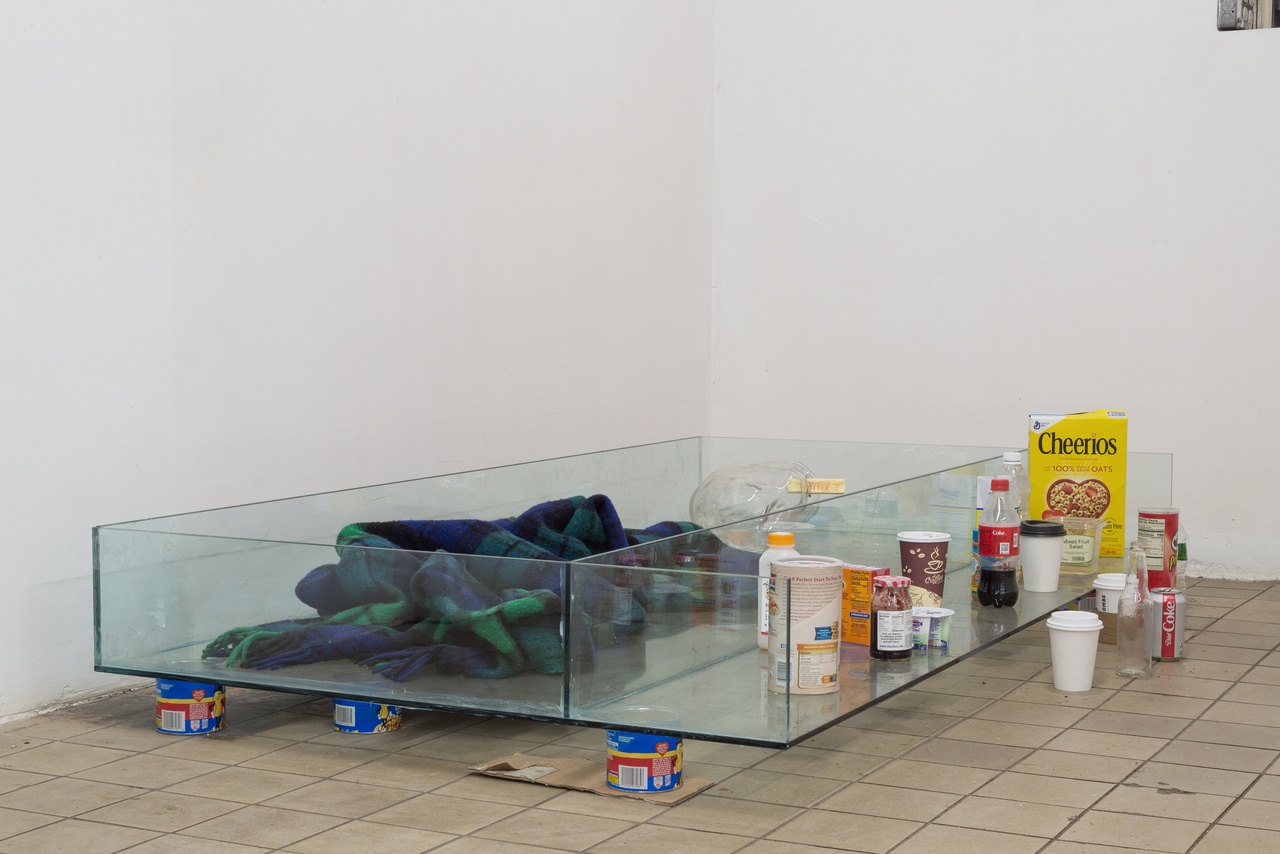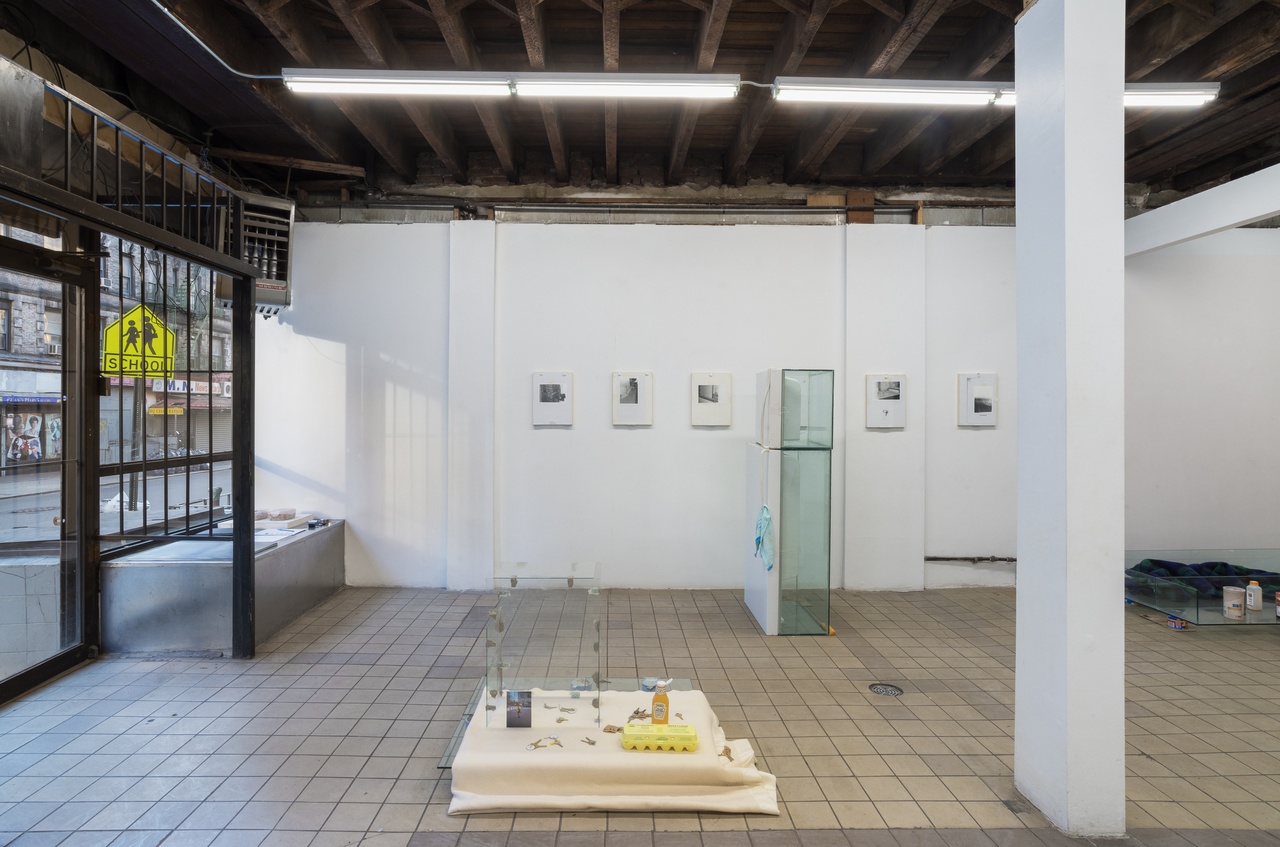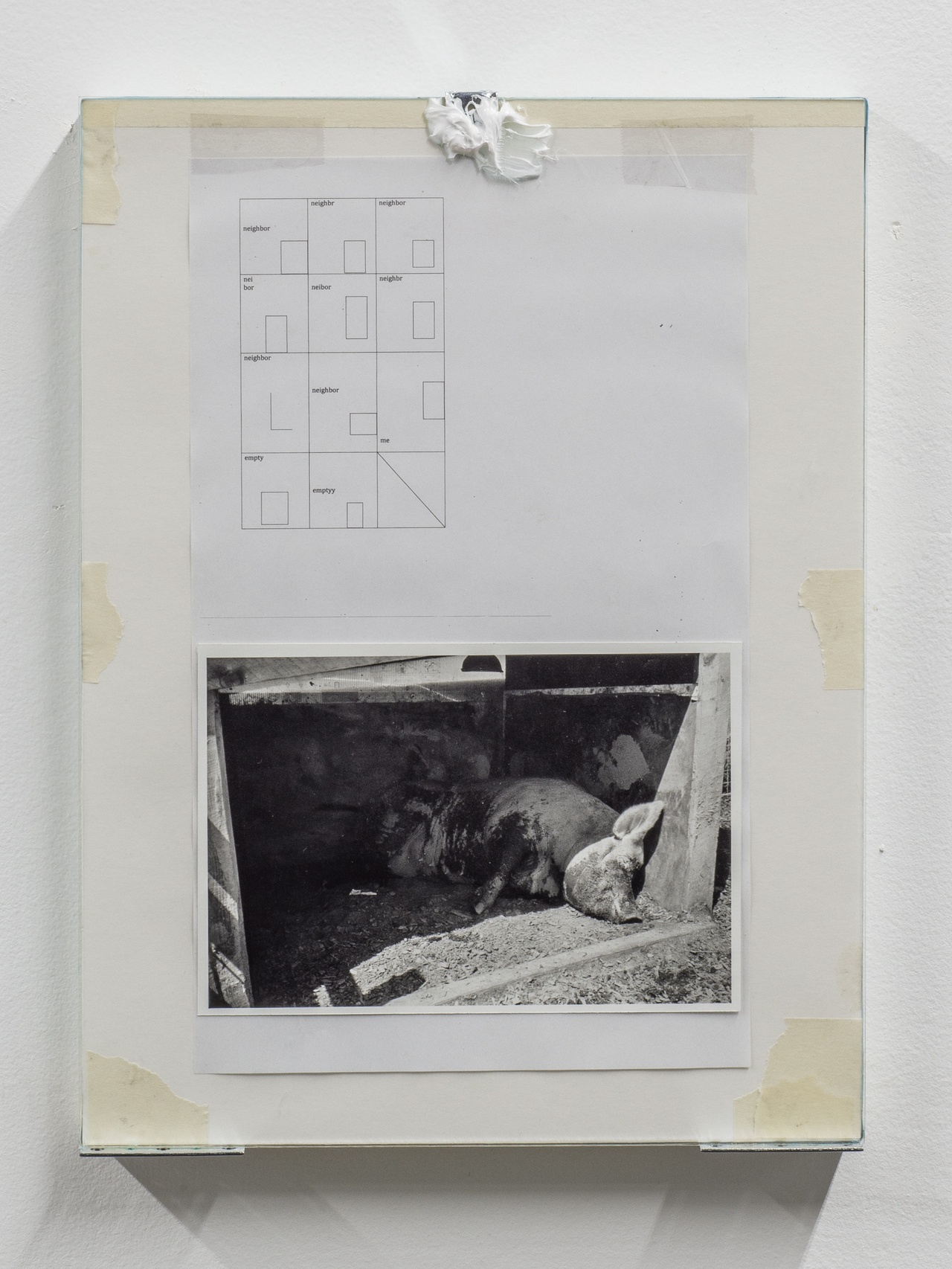Live in Your Head: Notes on Win McCarthy by Josephine Graf

Win McCarthy, “City Standing Up,” 2019
- The events of human life, be they public or private, are so intimately bound up with architecture, that the majority of observers can reconstruct nations or individuals in the full reality of their behavior from the remnants of their public monuments or the exhibition of their domestic remains.
- Honoré de Balzac, The Quest of the Absolute
One night sometime around 500 BCE, a Greek poet named Simonides of Ceos is said to have stepped out of a dinner party just moments before the building where he was seated crumbled behind him, crushing all who were inside. When pressed, he identified the remains of the less fortunate guests by reenvisioning the seating arrangement. This collision of space and memory inspired a mnemonic touted by the ancient Greeks and Romans and repopularized during the Renaissance; the “method of loci,” as it came to be called, maps information onto spatial schemas for easier recall. The mind becomes a scaffold. To remember is to clad it with information and stroll through the virtual palace.
That the psyche should be considered spatially is not necessarily self-evident, but the idea of mental topography has a long history. In Sigmund Freud’s “iceberg” diagram, for example, consciousness – the tip of the iceberg – peeks out above sea level, while the hulking unconscious lies submerged, waiting to clip the proverbial Titanic. Gaston Bachelard, following Carl Jung, speaks of the attic and cellar of the mind. As with the method of loci, the mind becomes a plastic substance to be charted and traversed, given form where it may in fact have none.
A similar cartography of the mind weaves through the work of New York-based artist Win McCarthy, whose sculptural practice – inflected by drawing, photography, and poetry – unfolds as an extended project of self-portraiture that nevertheless tests the limits (and sanity, perhaps) of that very endeavor. Rarely do we see his face. When we do, it is deranged, faded, or scaled down to near invisibility. In a series of works shown at Silberkuppe in 2018, glass masks – initially modeled on McCarthy’s face – repeat themselves, their features melting into non-human illegibility, like drugged-up death masks submitted to the devouring march of time. In earlier works, an interest in self-fashioning is more forthright. A 2015 exhibition at Off Vendome featured broad scrims of industrial plastic sheeting – the type used for packing art – stretched on freestanding metal frames. One was adorned with tiny cut-outs of the artist’s eyes and mouth, excised from photos and placed, off-kilter, over the expanse. Suddenly, the plastic became skin. An empty wrapper, it suggested a troubling thinness of subjectivity. You could see right through him.

“Win McCarthy: Apartment Life,” 2019, installation view
“I knew then surely that any thing would fracture if I looked hard enough,” reads a passage of text accompanying the Off Vendome exhibition. “My palms were now soaked, my pencil chewed up like a bit of driftwood in the sea, the stranger still staring back at me, brow furrowed, wearing my face like some cheap mask.” McCarthy’s works search for the self and find it exploded, at once everywhere and nowhere, undermining the assumption that looking will lead to seeing. Rather, it’s as if the more diligent the cartographer, the more confounding the map – and the cheaper the mask. The wavering legibility that results suggests a riposte to the narcissism of self-portraiture, and a degree of embarrassment around the whole endeavor. McCarthy’s works are not self-defeating, but they certainly question the ability to image the self in a world where an obsession with self-image blankets nearly all interaction. A 2015 work titled Diagrammatic includes a reticent self-portrait composed of typed words mapped onto the facial features they name – “eye, eye, nose, mouth, etc.” – as if only the most rudimentary language can be trusted where images come up short.
In the past three or so years, the map, plan, and model have begun to crop up in McCarthy’s work with greater frequency, shifting the terms of his previous inquiry and suggesting that the self might perhaps be better understood as an effect: not as image or language, but as a product of the spaces that surround it. These newer works – ramshackle architectures in miniature fastened together out of foamcore and hot glue – offer aerial views of modest structures. Enclosed within are snapshots, scraps of poetry, newspaper clippings, weather reports, and calendars – the things, both personal and boilerplate, that we use to tell time as it passes. Take January ’17 calendar (Der Fuß des Künstlers), for example, a 2017 work made of foamcore that includes, tacked within its recesses, a small photograph of the artist’s bare foot peeking out from bedcovers – a nod to the fleshy mortality of Adolph von Menzel’s painting of his own foot from 1876. (Locating the work in another, more recent, past is the Obama-era State of the Union speech playing on a computer monitor beyond the bed in McCarthy’s image – a low-key post-election indictment of Left complacency, maybe). Snapshots of friends and half-finished works in the studio, the New York skyline, pebbles, and clipped-out coupons surround this central image, forming a constellated portrait of the artist at a particular moment in time – January 2017, to be precise, as hinted at by a tiny desk calendar stuck in the lower-right corner of the piece. Hung vertically on the wall and gridded in pencil, with lines protruding as walls, the work merges the floorplan and the calendar – reminding us of the deceptively simple fact that a calendar is really just a rudimentary spatialization of time.
“Memories are motionless,” writes Bachelard in The Poetics of Space, “and the more securely they are fixed in space, the sounder they are.” [1] Labyrinthine, like slightly clotted neural pathways, McCarthy’s works sketch the coordinates of where these recollections might reside – where to stick the present, as it quickly becomes past, within the messy city of the mind. The commonplace metaphor of “interior space” is here literalized. In Apartment Life, a 2016 work in the collection of the Whitney Museum of American Art, a metal cage perched amid a precarious wooden tower encloses a miniature photograph of the artist’s face. A spotlight rakes the image from above, as if willing it to match the stature of the wooden body that enfolds it. Like many of McCarthy’s works, it is at pains to ensnare that which is at risk of slipping away. Yet his traps are leaky, made not only from foamcore and scraps of wood, but also cardboard, glass, raw clay, water, pipes, perishable foods, pebbles, discarded appliances. Defiantly analog, they court entropy and fracture, as if only momentarily swept up into form. There’s an aesthetic here, but it’s no simple post-Minimalist hangover. The provisionality of his materials reflects – enacts, even – the Sisyphean task of pinning oneself down in the face of time. How better to sketch the awful fragility of our human architecture than with foamcore and glue. We are all, in the end, middle-school projects gone slightly wrong.

Win McCarthy, “Street Scene (Friday),” 2019
As I write this piece, construction of one of the largest single developments in the history of Manhattan, Essex Crossing, marches into its fourth year. Built largely on land razed in 1967 along Delancey Street in the Lower East Side as part of the Seward Park Extension Plan masterminded by Robert Moses (and never fully redeveloped due to political infighting), Essex Crossing, by its projected completion in 2024, will have erased the largest contiguous swath of “undeveloped” land left in lower Manhattan, as well as several existing buildings (the beloved Essex Market among them). Condos, office space, and a handful of big box stores – Target, Trader Joes – are rising in their stead. The suburbanization of New York trucks right along, with Hudson Yards fresh in the collective mind. Featured on the Essex Crossing website, you can find a time-lapse video, compiled of multiple aerial views captured each hour from January 27, 2016 through to the present day, which tracks the high-rises currently under construction as they emerge from what was previously a series of parking lots. Click play and the structures careen into the sky – hours, days, seasons, compressed into mere minutes.
It seemed odd, at first glance, that a developer would want the violence of these changes – which appear from above as gashes on the urban skin – so readily accessible, so easily rewindable. “Hey, look! We’re on camera!” reads the click-through title. But the video’s accelerated advancement tool also fosters a sense of inevitability that it presupposes its viewer to already have. Of course it should be so. All that is solid melts into air. Or, perhaps more aptly: all that was air becomes solid. In a city such as New York, a kind of collective acceptance of precarity, an assumption that familiar landscapes will disappear and that any undeveloped – and therefore potentially unmanaged – space will be corralled by capital, pervades as a tacit mode of survival.
McCarthy opened his most recent solo exhibition at Svetlana, a storefront gallery located a short walk south of Essex Crossing, this past January. Titled “Apartment Life” (like the aforementioned sculpture of 2016), it was anchored by five large rectangular structures cobbled together from plexiglass and household appliances put out to pasture (refrigerator doors, a weathered medicine cabinet). Bedecked with small snapshots and miniature window frames and strewn with half-consumed jars of condiments, paper coffee cups, cans of peanuts, and even a carton of eggs, they resembled a small city of transparent tenement buildings whose shelf life, like that of the perishables they contained, was numbered.
One such work, Development (2019), contained within its plexiglass facade a medicine cabinet left slightly ajar, tubes of back pain ointment and toothpaste stashed within. Viewed from a certain angle, its mirrored door reflected two small, flat works installed across the gallery: images of Essex Crossing. More precisely, these were photographs the artist took of 3D models housed in the developer’s sales office. Printed in a grainy black and white, the images featured eerily manicured roof decks dotted with rows of silent sunbathers and solitary street scenes. In one, a rule-abiding monad stands alone on a corner, eternally waiting to safely cross the empty street. The developer’s wish images of a sleek urban future become, in these works, like stills from a dystopian film noir straight out of Jane Jacobs’s nightmares.
I can’t say whether it was purposeful that the lonely images of Essex Crossing were reflected in a work titled Development, which figures the building as a fragile self – back pains, bad breath and all – but the convergence certainly raises questions about the ways in which subjectivity is contiguous with the spaces it moves through and what happens when those spaces are then taken away or reconfigured. As in past works, transparent materials such as glass and plexi featured prominently in this exhibition; together with the many half-opened jars, they suggest an interest in how we parse interior and exterior, container and contained, private space from public space, and the dubious value in drawing such distinctions in the first place. There is a political potential to blurring these lines, to conceiving of the self, as McCarthy’s works do, as somewhat scattered, adhered everywhere, intermingled with other lives and streets and buildings; by the same token, the self gets spread thin, is all the more easily erased when these things get razed. If the self is a construction, then it follows that it can be torn down and redeveloped, too.
“Windows all open and the radiators clanging […] The inside of New York meets the outside at the windowsill,” reads the press release, nodding to the strange truth that New York apartments tend to be zealously overheated, but also to the difficult straits faced by many in a city where “home” is precarious and public space in short supply. You get stuck on the proverbial windowsill. The install images on Svetlana’s website open with an uncommon shot looking into the gallery from the street, duplicating this liminality while also acknowledging the gallery’s vulnerability to the larger city on the one hand, and own its role in gentrification on the other.
And yet “proverbial” is precisely the problem, for if past works took the floorplan as an extended domain of the self, here McCarthy seems to run up against the limits of metaphor. How can you map the self in a city where attachment to space is disregarded (and not indiscriminately – as we know, some attachments are seen as more valid than others) and the city valued above the subjects that comprise it? “For the notion that the city speaks for itself,” Rosalyn Deutsche writes, “conceals the identity of those who speak through the city.” [2] This is not a show about Essex Crossing, per se; rather, it is about the possibility of a productive nostalgia – and not the idealizing kind. Cities, like selves, are never perfect and never static. It is about remembering what and who gets lost and how we decide what to hold onto. The method of loci, McCarthy reminds us, might be both an elegy and a small act of protest. We don’t just live on screens, or in our heads.
“Win McCarthy: Apartment Life,” January 19–February 24, 2019, Svetlana, New York.
Josephine Graf is a writer and curator based in New York, USA.

